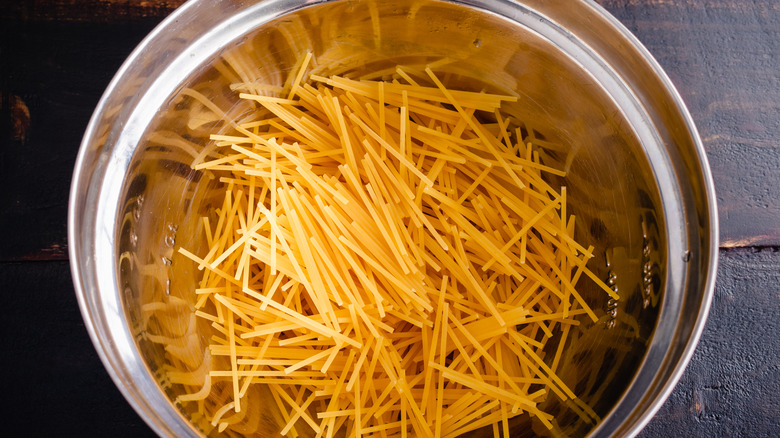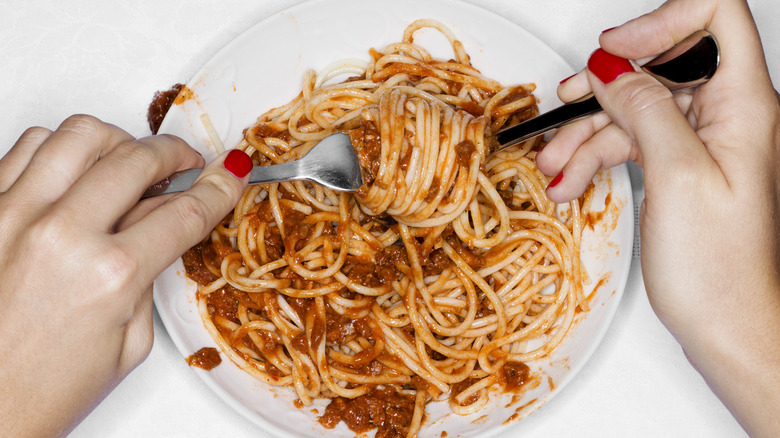The One Pasta Rule You Should Never Break, According To Alex Guarnaschelli
Pasta is one of the most versatile dishes and a staple of Italian cooking, with the noodles coming in all shapes and sizes and each variation meant to pair with a different sauce or filling. From fettuccine with creamy Alfredo to spaghetti with a classic red tomato sauce, the possibilities are endless.
However, there is one faux pas that chef Alex Guarnaschelli told Food Network she would never commit, no matter what dish she's making: "You do not break pasta, under any circumstances." For most Italians, breaking your pasta is a big no-no. Snapping your long-stranded pasta (such as plain spaghetti, linguini, or angel hair) in half will affect the dish's aesthetics, texture, and cohesion, and will send any Italian nonna into a tailspin.
Some people might feel compelled to snap their longer pasta in half before throwing it in the pot to boil, thinking it will significantly reduce cooking time. Others think it will allow the pasta to cook more evenly since the ends of the longer strands can stick out of the pot for a few seconds, but neither are true. In fact, most chefs recommend just relying on a taller pot for long pasta or using a utensil to push the straggling ends of your spaghetti into the boiling water.
Breaking pasta can be seen as bad manners and bad technique
There is not necessarily a hard and fast rule in Italian cooking against breaking your pasta, even though there are rumors that breaking spaghetti is illegal in Italy. While these rumors are entirely false, breaking your pasta is generally frowned upon and some would consider it bad manners. "Spaghetti and other long pasta requires skill and care by the pasta maker," food historian Francine Segan told Delish. "It's an insult to their artisan craft to destroy the intended length."
It's also considered bad technique: If the noodles are too short they can fall off your fork, become difficult to eat, or create an unnecessary mess with sauce splatter, since longer strands work better to contain the sauce. Spaghetti strands should be kept at their original length, around 10 inches, and the same goes for other long pasta types like fettuccine and linguine.
These are, of course, the practical reasons why you should leave your pasta intact. Still, there are other not-so-concrete reasons too, as some superstitious chefs even consider breaking your pasta to be bad luck. Like most superstitions, there's not a solid explanation as to why it's considered unlucky, though some have claimed an association with poverty and hunger.
The way pasta is made and consumed around the world
Part of the reason Italians don't break their pasta comes down to how the noodles wrap around the fork. Typically, you're supposed to twirl long pasta against the side of your bowl and onto your utensil, a method meant to gather as much sauce as possible into a neat cylinder of carbs to ensure the perfect bite each time.
There are exceptions to the rule, such as for soups like pasta fagiole, but there are also exceptions for cuisines other than Italian, too. For example, noodles originated in East Asia and were typically slurped from a bowl and broken up with teeth. When noodles made their way over to Italy and evolved into the staple of Italian cooking we know today, they were eaten differently, with the starchy strands twirled onto the tines of a fork and consumed in a single bite.
There are other exceptions as well, like vermicelli rice noodles, which are often broken up for use in several Indian, Chinese, or Japanese dishes to make them easier to eat. But with Italian pasta, which comes in so many different shapes, the form your pasta takes is intentional.



